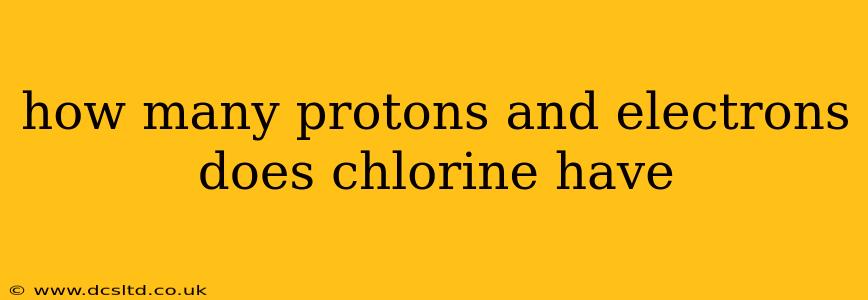Chlorine, a crucial element in many aspects of our lives from household cleaning to industrial processes, has a unique atomic structure that defines its properties. Understanding its number of protons and electrons is fundamental to grasping its chemical behavior.
What is the Atomic Number of Chlorine?
To determine the number of protons and electrons in a chlorine atom, we need to know its atomic number. The atomic number represents the number of protons in the nucleus of an atom. For chlorine, the atomic number is 17. This means a neutral chlorine atom contains 17 protons.
How Many Electrons Does Chlorine Have?
In a neutral atom, the number of electrons orbiting the nucleus is equal to the number of protons. This ensures a balance of positive and negative charges, resulting in a net charge of zero. Therefore, a neutral chlorine atom also has 17 electrons.
What About Chlorine Ions?
It's important to note that this is true for a neutral chlorine atom. Chlorine readily forms ions, which are atoms that have gained or lost electrons. Chlorine is highly electronegative, meaning it strongly attracts electrons. It typically gains one electron to achieve a stable electron configuration, forming a chloride ion (Cl⁻).
A chloride ion (Cl⁻) still has 17 protons, but it now has 18 electrons due to the extra electron it has gained. This extra electron gives it a negative charge.
How Many Protons and Electrons Does Chlorine-35 Have?
Chlorine exists in two naturally occurring isotopes: chlorine-35 and chlorine-37. Isotopes are atoms of the same element with the same number of protons but a different number of neutrons. The number after the element's name (e.g., 35 in chlorine-35) indicates the mass number (protons + neutrons).
Chlorine-35, the more abundant isotope, still possesses 17 protons and (in its neutral state) 17 electrons. The difference between chlorine-35 and chlorine-37 lies in the number of neutrons, not the number of protons or electrons.
What are the Electron Shells of Chlorine?
The 17 electrons of chlorine are distributed across three electron shells:
- First shell (K-shell): 2 electrons
- Second shell (L-shell): 8 electrons
- Third shell (M-shell): 7 electrons
This arrangement explains chlorine's reactivity. The incomplete outermost shell (7 electrons instead of a full 8) drives its tendency to gain one electron to achieve a stable octet, thus forming the chloride ion.
Why is understanding the number of protons and electrons important?
Knowing the number of protons and electrons in an atom is crucial for understanding its:
- Chemical reactivity: The number of electrons in the outermost shell determines how an atom will interact with other atoms.
- Ionic and covalent bonding: Chlorine's tendency to gain an electron leads to the formation of ionic bonds (with metals) and covalent bonds (with non-metals).
- Physical and chemical properties: The electron configuration significantly impacts the element's properties, like melting point, boiling point, and reactivity.
In conclusion, a neutral chlorine atom contains 17 protons and 17 electrons, while a chloride ion (Cl⁻) has 17 protons and 18 electrons. Understanding this fundamental aspect of chlorine's atomic structure is key to comprehending its behavior and its significant role in various chemical and biological processes.
